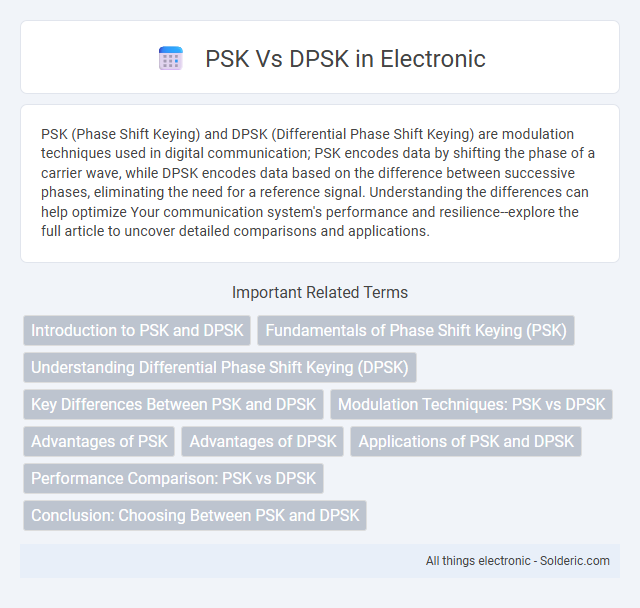PSK (Phase Shift Keying) and DPSK (Differential Phase Shift Keying) are modulation techniques used in digital communication; PSK encodes data by shifting the phase of a carrier wave, while DPSK encodes data based on the difference between successive phases, eliminating the need for a reference signal. Understanding the differences can help optimize Your communication system's performance and resilience--explore the full article to uncover detailed comparisons and applications.
Comparison Table
| Aspect | PSK (Phase Shift Keying) | DPSK (Differential Phase Shift Keying) |
|---|---|---|
| Modulation Type | Coherent phase modulation | Differential phase modulation |
| Detection Method | Coherent detection using a reference carrier | Non-coherent detection without a reference carrier |
| Complexity | Higher due to phase synchronization requirement | Lower, simpler receiver design |
| Error Performance | Better bit error rate (BER) performance in AWGN channels | Worse BER performance compared to PSK |
| Use Cases | High-performance communication systems, satellite, and radar | Wireless networks, optical communications, environments with phase ambiguity |
| Signal Reference | Requires exact phase reference | Uses phase difference between successive symbols |
Introduction to PSK and DPSK
PSK (Phase Shift Keying) and DPSK (Differential Phase Shift Keying) are digital modulation techniques used to transmit data by varying the phase of a carrier signal. PSK encodes data by changing the phase directly according to the input bits, while DPSK conveys information based on the difference between consecutive phases, eliminating the need for a coherent reference signal. Understanding the distinctions between PSK and DPSK can help you choose the most efficient modulation method for your communication system.
Fundamentals of Phase Shift Keying (PSK)
Phase Shift Keying (PSK) modulates the phase of a carrier signal to represent digital data, where different phase angles correspond to distinct symbols. Binary PSK (BPSK) uses two phases separated by 180 degrees for binary '0' and '1', ensuring robust noise immunity and simple implementation. Differential PSK (DPSK) encodes data based on phase changes between successive symbols, eliminating the need for coherent detection and simplifying receiver design.
Understanding Differential Phase Shift Keying (DPSK)
Differential Phase Shift Keying (DPSK) encodes data by comparing the phase of the current signal to the previous one, eliminating the need for a reference phase during demodulation. This technique enhances noise immunity and simplifies receiver design compared to standard Phase Shift Keying (PSK), which relies on absolute phase detection. Your communication system benefits from DPSK's robustness in environments with phase ambiguity and rapid phase changes.
Key Differences Between PSK and DPSK
Phase Shift Keying (PSK) modulates the carrier phase directly to represent data, requiring coherent detection with precise phase reference for accurate demodulation. Differential Phase Shift Keying (DPSK) encodes data changes in phase relative to the previous symbol, enabling non-coherent detection that eliminates the need for a reference phase. PSK generally offers better noise performance but demands more complex receivers, whereas DPSK trades some performance for simpler, more robust detection in environments with phase ambiguity.
Modulation Techniques: PSK vs DPSK
PSK (Phase Shift Keying) encodes data by varying the phase of a carrier signal, requiring a coherent reference signal at the receiver for accurate demodulation. DPSK (Differential Phase Shift Keying) eliminates the need for a reference by encoding data as phase differences between successive symbols, enhancing robustness in noisy environments. Your choice between PSK and DPSK impacts system complexity and performance, with DPSK offering simpler receiver design at the cost of slightly higher error rates.
Advantages of PSK
PSK (Phase Shift Keying) offers significant advantages in digital communication systems, including higher spectral efficiency and better noise immunity compared to other modulation schemes. It enables reliable data transmission over bandwidth-constrained channels by representing data through discrete phase changes, reducing error rates in noisy environments. PSK's compatibility with coherent detection techniques enhances overall system performance and supports higher data rates in wireless and satellite communication networks.
Advantages of DPSK
DPSK (Differential Phase Shift Keying) offers enhanced noise immunity compared to PSK (Phase Shift Keying) due to its differential encoding, which eliminates the need for a coherent reference signal at the receiver. This results in simpler receiver design and better performance in environments with phase ambiguity or rapid phase variations. DPSK also reduces error rates in multipath fading channels, making it advantageous for wireless communication systems.
Applications of PSK and DPSK
PSK (Phase Shift Keying) is widely used in wireless communication systems, including Wi-Fi, RFID, and satellite transmissions, due to its ability to efficiently encode data with robust noise resistance. DPSK (Differential Phase Shift Keying) finds applications in optical fiber communication and Bluetooth technology, offering simplified receiver design by eliminating the need for a coherent reference signal. Your choice between PSK and DPSK should consider factors like system complexity, error performance, and synchronization requirements specific to your communication application.
Performance Comparison: PSK vs DPSK
PSK (Phase Shift Keying) generally offers better bit error rate (BER) performance under ideal conditions due to its coherent detection method, which accurately tracks carrier phase. DPSK (Differential PSK) avoids the need for complex phase recovery circuits, enhancing system robustness in environments with rapid phase variations but at the cost of slightly higher BER. Your choice between PSK and DPSK should consider the trade-off between performance reliability and implementation complexity in your communication system.
Conclusion: Choosing Between PSK and DPSK
PSK offers straightforward implementation with higher spectral efficiency, making it ideal for systems requiring robust data rates and simpler receiver designs. DPSK eliminates the need for complex phase synchronization by encoding data in phase changes, enhancing performance in environments with rapid phase variations or limited receiver complexity. Selecting between PSK and DPSK depends on the trade-off between system complexity, channel conditions, and the requirement for efficient spectrum utilization.
PSK vs DPSK Infographic

 solderic.com
solderic.com